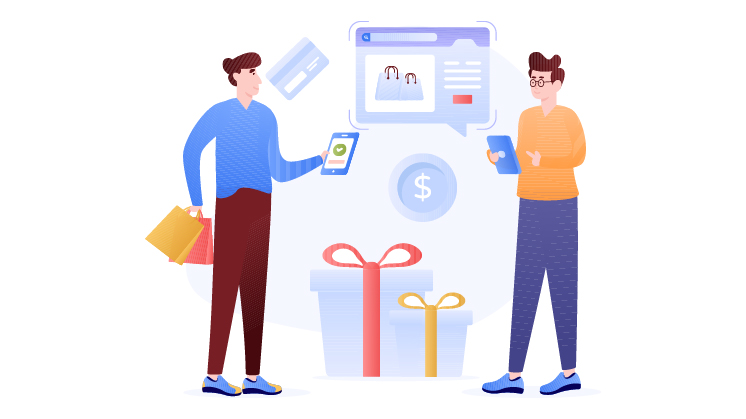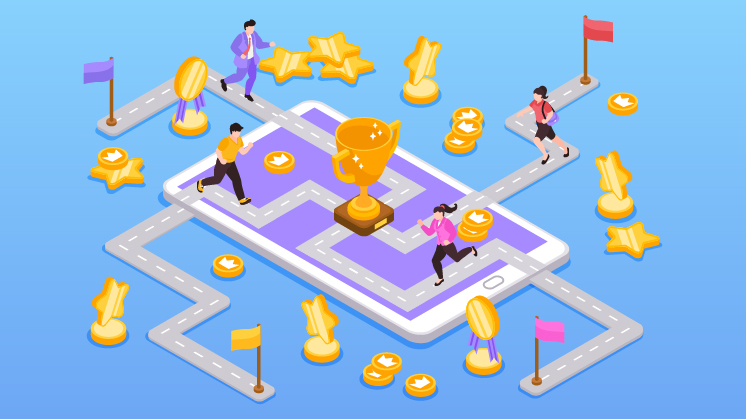Imagine a highly motivated sales floor where employees are actively competing, working together, and celebrating their successes – all while doing their daily jobs. This is how gamification in sales works. Businesses may create engaging, fulfilling experiences that enhance sales processes by leveraging our natural inclination towards games and competitiveness.

Ideas to gamify your sales process are not restricted to leaderboards or points and rewards systems. It all comes down to building a system that inspires, informs, and enables your sales force to perform at unprecedented levels. This extensive guide covers 15 useful and actionable sales gamification ideas. All these sales gamification tips are supported by real and practical advice to help you improve your sales numbers.
1. Setup Clear and Concise Goals
Every effective sales gamification idea must start with well-defined and attainable goals. These objectives have to be:
- Time-bound
- Relevant
- Specific
- Measurable
- Achievable
For instance, instead of aiming for the general “increase sales,” make a target more specific like “increase monthly sales by 15% within the next quarter.” This makes the sales tracking process concrete with a clear goal to strive towards.
2. Create a System of Points and Rewards
Create a points and rewards system to recognize different sales achievements and activities. This sales recognition system may consist of the following:
- completing transactions
- Scheduling conferences
- Making chilly calls
- Following up with emails
- Getting compliments from clients
Point values should be assigned according to the significance and complexity of each action. This keeps team members from concentrating on just one element of the sales process and promotes a balanced approach to sales activity.
3. Implement Leaderboards
As one of the traditional sales gamification ideas, leaderboards can massively increase motivation and healthy competition. Think about making several leaderboards to identify the various strengths of your team:
- Best closers
- Most improved athletes
- Highest ratings for client satisfaction
- Maximum new leads generated
To keep salespeople interested and engaged, update these leaderboards in real-time.
4. Offer Meaningful Rewards
Although acknowledgment is crucial, giving your sales team concrete awards can motivate them even more. Some meaningful rewards include:
- Bonus money
- Additional days off from work
- Tickets for experiences or events
- Opportunities for professional growth
- Selecting a subsequent sales territory
Recall that incentives that reflect the values and interests of your team work best.
5. Implement Team Challenges
Encourage teamwork by asking them to take part in team-based challenges. This may include:
- Organizing your sales staff into groups
- Establishing group objectives
- Reward points using a sales incentive software based on team accomplishments
Team challenges may ignite camaraderie, declutter communication, and promote knowledge sharing among your sales staff.
6. Use Milestones and Progress Bars
Progress represented visually can be quite inspiring. Put in place milestone markers or progress bars for:
- Specific goals for sales
- Group objectives
- Goals for the entire company
Find all possible ways to keep the momentum going and raise spirits. Also, celebrate when team goals are accomplished.
7. Gamify the Hiring and Onboarding Process
Incorporate sales gamification ideas into your onboarding and training procedures. Learning may become more efficient and pleasurable as a result. Think about:
- Establishing a “sales academy” with stages and qualifications
- Assessing knowledge with challenges and quizzes
- Badges are given out after finishing training modules.
This methodology has the potential to expedite the sales onboarding process for new hires and foster on-the-job education for seasoned sales team members.
8. Incorporate Badge System
An excellent approach to acknowledge particular accomplishments of a sales team is badges. You can reward badges in the following manner:
- “Cold Call Champion” badge to the most productive cold callers
- “Customer Whisperer” for salespeople with high scores for customer satisfaction
- “Deal Closer Master” to honor exceptional deal-closing performers.
To get the most impact out of badges, make sure they are eye-catching and prominently displayed.
9. Organize Sales Tournaments
Plan recurring sales competitions to add excitement to your sales funnel. These might be:
- Sprint difficulties every week
- Monthly sales competitions with a theme like ‘lead legends.’
- Major sales tournaments every three months
To stay interesting and target different parts of the sales process, change up the focus of these tournaments.
10. Use The Power of Storytelling
To increase the engagement of your gamification efforts, use the power of storytelling. Design a narrative around your sales objectives, such as:
- A drive to take over new markets
- A goal to protect consumers from inferior goods
- A trip to become legends in sales
Daily work would be transformed into something thrilling and meaningful when carried out in this way.
11. Use Technology
Software for gamification of sales might help you automate and improve your efforts. Seek out platforms that provide:
- Tracking data in real-time
- Adaptable dashboards
- Connectivity to your Customer Relationship Management system
- Remote access for sales teams that are constantly on the go
Using the correct technology can greatly simplify and improve the effectiveness of your gamification strategy’s implementation and management.
12. Offer Personalized Experience
Keep in mind that various team members may have varying motivations. It is always beneficial to include some personalization into your sales gamification plan, like:
- Allowing people to select their team name or avatar
- Presenting a range of options for incentives
- Letting team members establish individual goals in addition to group goals
Your entire sales team’s commitment and engagement can rise with this customized approach.
13. Implement Tiers-based Rewards
[IMAGE]
Provide a tier or level system through which members of the sales team can progress. This might consist of:
- Pro
- Rookie
- Expert
- Master
- Legend
Fresh obstacles, prizes, and acknowledgment have to be present at every stage. This provides team members with long-term objectives to strive toward and establishes a sense of growth.
14. Display Social Proof and Recognition
Recognize exceptional achievements of sales employees in public by using the power of social proof. This might consist of:
- Sending out company-wide emails with success stories
- showcasing exceptional work on your company’s social media accounts
- Establishing a virtual workspace or “wall of fame” in your business
Not only does receiving public appreciation encourage the reward recipients, but it also encourages others to aim for similar rewards.
15. Evaluate and Review Sales Gamification Ideas Regularly
Gamification ideas for sales that change with time are the most effective. Review your strategy frequently and make changes in light of the following:
- Your sales team’s feedback
- Modifications to your company’s objectives
- Changes in market circumstances
- New technological abilities
To keep your sales gamification approach productive and fresh, be ready to modify or even completely redo some of its components.
FAQs
Q: What are some unique ways to incorporate gamification elements into sales strategies?
Here are some of the out-of-the-box sales gamification strategies
- Design a virtual ‘sales city’ and ask sales employees to create an empire with the bricks of their performance
- Employ a ‘boss battle’ mechanism that will allow top sales performers to challenge top sales executives in a friendly manner
- Use AR/VR technology for sales meetings and training sessions
- Design an interactive ‘fantasy league for sales’ and create a leaderboard to compare and reward sales teams for various sales tasks based on sales efforts
Q: How can I measure the effectiveness of sales gamification techniques?
For measuring the impact of sales gamification ideas and strategies, consider doing the following:
- Keep a log of KPIs before and after the application of sales gamification ideas
- Carry out sales gamification surveys to measure employee engagement
- Review employees behavior after implementing gamified sales targets such as no. of follow up mails sent and cold calls made etc.
- Deeply analyze sales trends and compare them with customer satisfaction.
- Do A/B testing to analyze sales gamification approaches
Q: What are the most common mistakes to avoid when implementing sales gamification?
Some sales gamification mistakes you should avoid:
- Too much concentration on competition while ignoring collaboration
- Not making the gamification system easy to use or, conversely, making competition difficult to understand
- No synchronization between gamification objectives and the sales targets
- No adjustment and review of the gamification system that is creating boredom
- No concentration on a customized gamification approach and relying on a one-size-fits-all approach
Q: Are there any real-life examples of successful sales gamification campaigns?
Following are real-world examples of sales gamification
- After Xerox introduced a gamified training program called “Stepping Up,” their sales engineers’ productivity went up by 8% in just six months.
- SAP increased employee engagement by 70% and deal closure rates by 40% via a gamification strategy.
- Hewlett Packard Enterprise achieved a 100% boost in sales knowledge retention through the gamification of its sales enablement process.
Q: How do different industries use sales gamification ideas differently?
Every industry applies sales gamification strategies differently. Here’s how:
- Tech: Points and rewards for demonstrating product knowledge
- Financial services: Digital badges for outstanding legal and corporate compliance along with sales performance
- Pharma: Sales rewards on a number of new partnership deals with pharma retailers
- Real estate: Ranks and badges for the most number of property showing and client finalization
Final Words
There is no better way to grow your business than implementing solid sales gamification ideas that are discussed in this blog. All you need is to ensure the essence of gamification i.e. fun and relevance are not missing while you are gamifying your website. So, just plug-in these gamification tactics, align them with your sales objectives and you are good to go.



